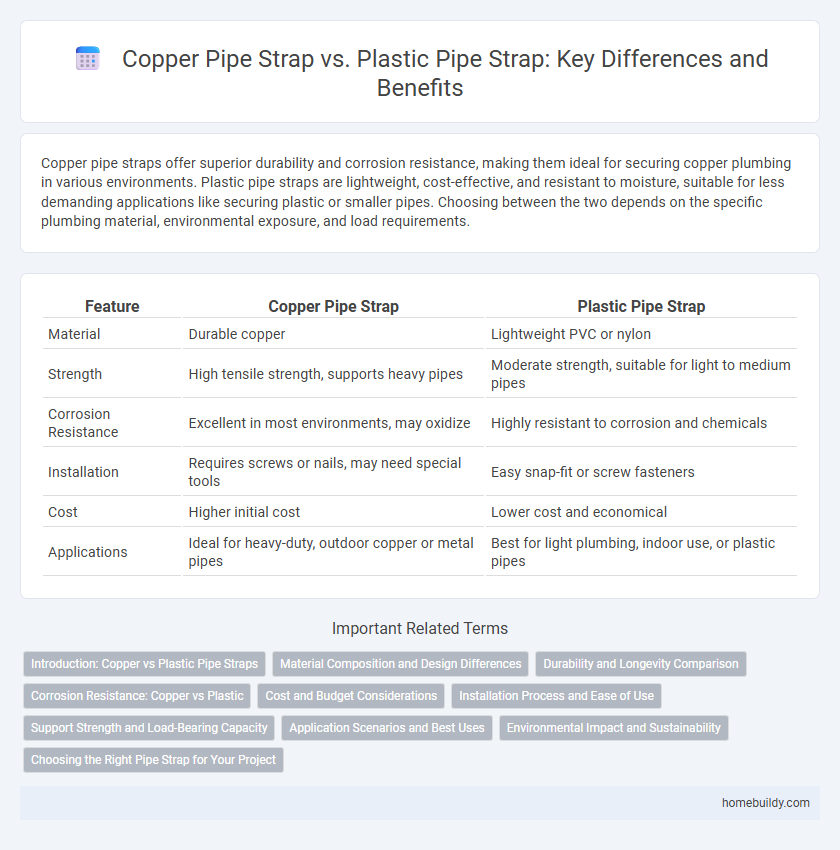Copper pipe straps offer superior durability and corrosion resistance, making them ideal for securing copper plumbing in various environments. Plastic pipe straps are lightweight, cost-effective, and resistant to moisture, suitable for less demanding applications like securing plastic or smaller pipes. Choosing between the two depends on the specific plumbing material, environmental exposure, and load requirements.
Table of Comparison
| Feature | Copper Pipe Strap | Plastic Pipe Strap |
|---|---|---|
| Material | Durable copper | Lightweight PVC or nylon |
| Strength | High tensile strength, supports heavy pipes | Moderate strength, suitable for light to medium pipes |
| Corrosion Resistance | Excellent in most environments, may oxidize | Highly resistant to corrosion and chemicals |
| Installation | Requires screws or nails, may need special tools | Easy snap-fit or screw fasteners |
| Cost | Higher initial cost | Lower cost and economical |
| Applications | Ideal for heavy-duty, outdoor copper or metal pipes | Best for light plumbing, indoor use, or plastic pipes |
Introduction: Copper vs Plastic Pipe Straps
Copper pipe straps offer superior durability and corrosion resistance, making them ideal for securing copper piping in plumbing and HVAC systems. Plastic pipe straps provide lightweight, cost-effective support with resistance to moisture and chemicals, suitable for non-metallic and low-pressure applications. Choosing between copper and plastic pipe straps depends on the environmental conditions, load requirements, and the type of piping being installed.
Material Composition and Design Differences
Copper pipe straps are made from solid copper, offering superior corrosion resistance and durability, ideal for securing copper pipes in plumbing systems. Plastic pipe straps are typically composed of PVC or nylon, providing lightweight, flexible support but with less strength and longevity compared to copper straps. The design of copper pipe straps usually features a robust, rigid structure for firm pipe retention, while plastic straps emphasize ease of installation with flexibility and corrosion-free properties.
Durability and Longevity Comparison
Copper pipe straps exhibit superior durability and longevity compared to plastic pipe straps due to their resistance to corrosion, UV radiation, and extreme temperatures. Plastic pipe straps may degrade over time when exposed to sunlight and fluctuating weather conditions, leading to brittleness and eventual failure. The inherent strength of copper ensures long-term secure pipe fastening in both residential and industrial plumbing applications.
Corrosion Resistance: Copper vs Plastic
Copper pipe straps offer excellent corrosion resistance in standard plumbing environments but can suffer from galvanic corrosion when in contact with dissimilar metals and moisture. Plastic pipe straps provide superior corrosion resistance as they are non-metallic and immune to rust or galvanic reactions, making them ideal for moist or corrosive applications. The choice depends on the environmental conditions and the potential for metal interaction, with plastic being more durable in highly corrosive settings.
Cost and Budget Considerations
Copper pipe straps generally have a higher upfront cost compared to plastic pipe straps due to the price of copper material and its durability advantages. Plastic pipe straps offer a more budget-friendly option, making them suitable for projects with tight cost constraints or non-load-bearing applications. Choosing between the two depends on balancing long-term durability benefits against initial budget limitations.
Installation Process and Ease of Use
Copper pipe straps offer a straightforward installation process with high durability and strong support, making them ideal for securing copper piping in plumbing systems. Plastic pipe straps are lightweight and easier to handle but may require additional tools for fastening and are less durable in extreme temperatures. Ease of use favors plastic straps for quick setups, while copper straps provide long-term reliability in installation.
Support Strength and Load-Bearing Capacity
Copper pipe straps provide superior support strength and load-bearing capacity compared to plastic pipe straps, making them ideal for heavy-duty plumbing applications. The metal's rigidity and durability prevent deformation under stress, ensuring secure fastening of copper pipes in various environments. Plastic pipe straps, while lightweight and corrosion-resistant, typically offer lower tensile strength and are better suited for light to moderate load conditions.
Application Scenarios and Best Uses
Copper pipe straps offer exceptional durability and corrosion resistance, making them ideal for secure mounting of copper plumbing and heating pipes in residential and commercial buildings. Plastic pipe straps provide flexibility and cost-effectiveness, suitable for lightweight applications such as securing PVC or PEX pipes in irrigation systems and temporary installations. Choosing between copper and plastic pipe straps depends on factors like pipe material, environmental exposure, and load-bearing requirements to ensure optimal performance and longevity.
Environmental Impact and Sustainability
Copper pipe straps exhibit higher durability and recyclability, making them more environmentally sustainable compared to plastic pipe straps. Plastic pipe straps contribute to microplastic pollution and are often derived from non-renewable petroleum resources, raising sustainability concerns. Copper's ability to be fully recycled without loss of quality significantly reduces landfill waste and resource consumption.
Choosing the Right Pipe Strap for Your Project
Copper pipe straps offer superior durability and corrosion resistance ideal for plumbing projects requiring long-lasting support and exposure to moisture, whereas plastic pipe straps provide lightweight flexibility and cost-effectiveness suitable for temporary or indoor applications. Selecting the right pipe strap depends on factors like environmental conditions, load-bearing requirements, and budget constraints to ensure secure and efficient pipe fastening. Evaluating compatibility with pipe material and installation environment optimizes project longevity and performance.
Copper pipe strap vs Plastic pipe strap Infographic

 homebuildy.com
homebuildy.com